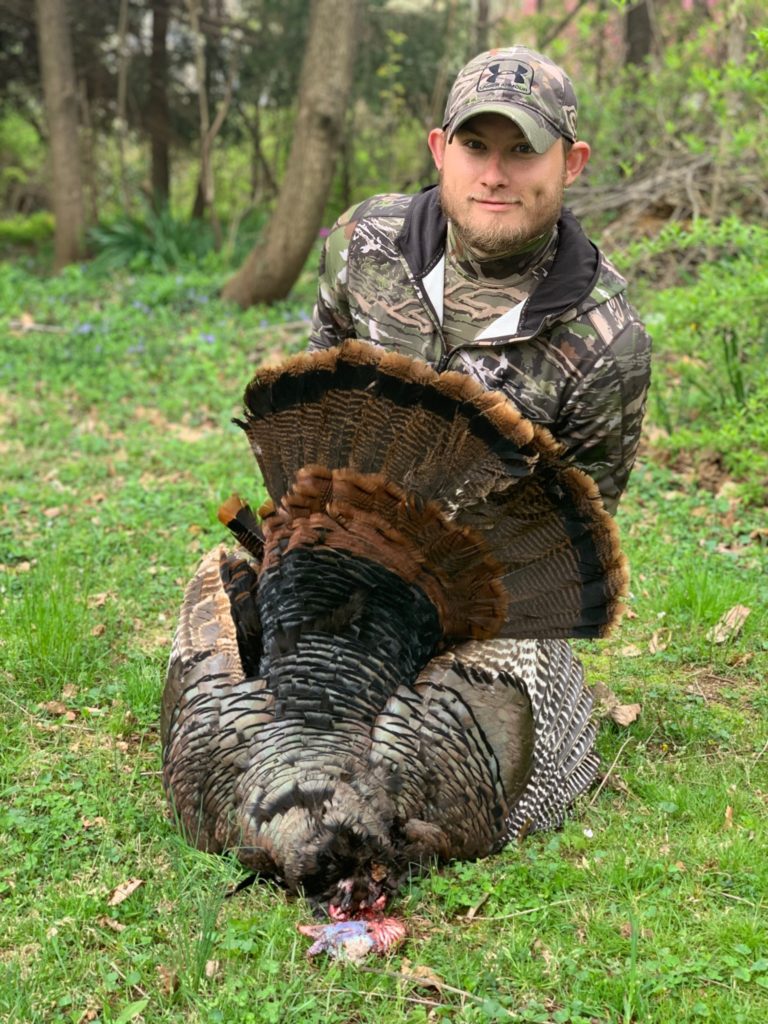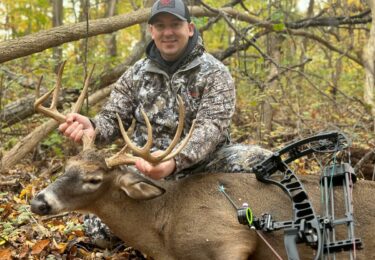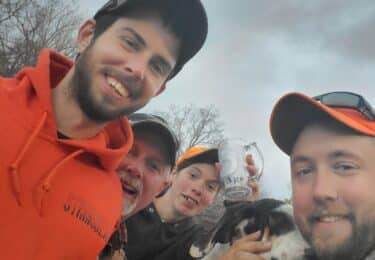Congratulations! All your diligence, hard work, and persistence have finally paid off, and you’ve shot the animal you’ve been after. However, what happens next could determine whether your hunt ends in celebration or lamentation. It is vitally important to keep your wit about you amongst the torrent of emotions that ebb and flow in the moments following the release of an arrow or the report of a gun. This simple inability, coupled with ignorance in basic knowledge of tracking and trailing technique, has caused more needless suffering and unrecovered animals than nearly anything else. This is also not limited to just the novice, for I have seen grown men who’ve hunted since their youth fall victim to the very same pitfalls. This doesn’t have to be you. In the following paragraphs, I will outline a simple formula to follow so that you (hopefully) will never have to cause unnecessary suffering and lose game again.
Pay Attention and Build a Story
For the sake of the narrative, from this point forward we will assume you’ve shot a whitetail deer with a bow from a treestand. The very first thing you need to do is calm your nerves and collect your thoughts. DO NOT attempt to do anything else until you’ve completely composed yourself and can think rationally and clearly. This could take thirty seconds or ten minutes, but no matter how long it takes to do so, do this first. Rushing through the steps because of excitement or panic is the worst thing you can do.
Next, start piecing together a chain of events to help give your tracking job a starting point. I personally find it most helpful to create a story. Your story begins the moment you break loose a shot. From this point forward, try to recall every single detail, no matter how seemingly insignificant it may be. For instance, was the flight path of your arrow completely unobstructed or did it hit something mid flight? Where did you hit the deer? Did you get good penetration/complete pass-through? What did the deer do when the arrow hit? Could you see it bleeding as it ran away? Where was the last place you could positively see the deer, and are there any landmarks or easily identifiable terrain features that could lead you back to that area (VERY important)? Were you able to see or hear it crash? The more of these questions you can answer before you even start looking for blood, the better informed you will be on what the deer likely did next, and in what condition it may be.
Form a Plan and Be Patient!
After you’ve built a story out in your head of what happened, evaluate what the different elements of that story mean. Now, make a game plan. For example, if you perceive a solid vital hit and the deer does a high “mule kick” with his back legs and/or “bulldozes” with his head with front legs slung low to the ground, there is a good probability you hit it in the heart. A heart shot will also bleed heavily. Running off quickly and with purpose after a solid vital hit is often indicative of a lung hit. If you perceive a less than ideal shot has occurred too far back and the deer jumps hunch-backed into the air, a liver or gut shot is most likely. If you see him favor a front or rear leg while running away the likelihood that you hit him there is high. Lastly, in my opinion, the deer that runs away nonchalantly and seemingly unafraid tells you the least unless you can physically see the deer bleeding. This is normally due to either a complete miss, glancing blow, or complete pass through from a fast shooting bow with a sharp broadhead. Sometimes everything happens so fast the deer doesn’t even notice.
Now that you’ve evaluated everything, it’s time to make a plan. The most important thing to remember is to give the deer time to expire peacefully. Although hotly debated among the hunting community, I believe that determining how long to wait before pursuing a wounded animal is simple: go back to your story. If the deer was hit well, bleeding heavily, and you could see it fall, give it twenty minutes from the last time you saw it move. Other than that, take into account all the factors and when in doubt, wait it out. Some good rules of thumb to follow are twenty to thirty minutes for a suspected heart shot, thirty minutes for a lung shot, two hours for a liver shot, and six to eight hours for a gut shot. My dad has a great saying that helps guide my wait time decisions: “there’s no such thing as too dead but there is such a thing as not dead enough.”
Analyze the Blood

Up to this point you should have a good idea of what happened and a game plan on how to begin your tracking job. Upon your descent from the tree, the first place you should start looking for blood and sign is the location you hit the deer. In the best case scenario, you will immediately find blood and/or your arrow.
Examine what you see and smell and compare this to your original idea of what happened. If the blood is prevalent, spattered, and bright red, that signifies an arterial bleed. This is most likely heart blood, but it could possibly be the femoral artery of the rear leg or carotid artery of the neck. If blood is a similar color but sparse and filled with hair, it is likely a muscular wound-probably shoulder, ham, back (brown hair), belly, or brisket (long white hair). If the blood is reddish-pink and bubbly, it is most likely lung blood. Dark red blood that smells like pennies is most likely liver blood. Any greenish or brown blood that has a putrid smell is most likely gut blood. Use this information to inform your next moves; any blood that isn’t favorable is usually best left to wait for a little while before continuing on.
If and when you decide to proceed, follow the blood and listen to what it tells you. If the trail becomes heavier and easier to follow, the deer is most likely not far away and lying dead. Remember too that not all blood will be on the ground. Look at bushes, shrubs, trees and other objects that he would have bled on or brushed against as he went by at the wound site. This is typically about hip height on the average person.
No Blood? Don’t Panic
In a perfect world, you would have no trouble at all finding lots of blood and will walk straight to your deer. We don’t always live in a perfect world. Sometimes, the trail begins to slow down or stop. Others, we don’t find blood right away. The important thing to remember is not to panic. Use your reasoning and work through a couple of steps.
First, think back to the story you created in your mind. If you can recall the last place you positively know you saw the deer, go there and begin your search. More often than not (especially with high velocity bows and rifles), an animal will take a few steps to start bleeding, so starting further down the trail may be the best strategy.
If your initial search yields nothing of value, just slow down and reassess. Go back and reexamine what you’ve done up to this point, ensuring you’ve recollected the events correctly and not missed anything. If you find a blood trail and it abruptly disappears, the deer may have simply changed direction. If this happens, just back up to the last place you found blood, no matter if it’s just a drop or two, and look around for other signs the deer has gone through. Things like broken branches, upturned leaves, and kick marks or footprints could lead you to more blood elsewhere. Another good point to remember is that wounded deer take the path of least resistance. Most often, a fatally wounded deer will run downhill in straight lines, seeking cover and water. Also just by nature of the wound, a deer will bleed more heavily at an obstacle crossing if it has to jump over or dive under said obstacle.
Another useful tactic if no blood is present is to go back to the point of impact or last blood. From there, make concentric circles starting and ending at the same point, then gradually increase the size of the circles until you discover a sign the deer has passed through. For example, if you come to the end of a blood trail, make a ten foot circle around the area looking for sign, and end back where you started. If you don’t find anything, open the circle up to twenty feet, then thirty feet, and so on and so forth until you find something. This technique works especially well in open terrain where other means of discovering a deer’s movements (like trees, leaves, and obstacles) are unavailable.
Call in the Cavalry
If by this point you haven’t successfully recovered your game, it’s time to sit and ask yourself the uncomfortable question: did you really hit the deer? If you’re sure you did, do you think the animal is mortally wounded or lying dead, or is the wound non-lethal? If you determine that you hit the deer in a lethal manner but still haven’t recovered it after exhausting the entirety of the steps thus far, it’s time to back out and call in the cavalry. Never be too proud to ask for help. Once the cavalry arrives you have a few options, the first of which is the classic grid search.
A proper grid search has the members of the search party spaced evenly across the search area, starting at the last known place of the deer. The group moves forward together slowly, looking for any trace of the animal they can find. You search until you have either found sign, the animal, or the search is called off.
Another popular new method is the use of a tracking dog. These are trained dogs that find the scent of blood or hair and follow it to the deer’s final resting place. However, not all fifty states and canadian provinces allow the use of tracking dogs. So before you hire one, check your state and local regulations to make sure it’s legal where you are. Additionally, these dogs can be fantastic, but should not be used as a crutch or excuse to not properly trail deer on your own. In my opinion, these dogs should only be used as a last resort before giving up hope, or in situations where a grid search isn’t feasible.
The thought of tracking game can be intimidating if you aren’t familiar with how to go about it correctly. However, as I’ve illustrated in the post above, it’s a matter of simple principles applied with patience. Pretty soon, nothing will get past you and you’ll be the guy everyone wants in deer camp. Moreover, the nourishment and meals will make it to your dinner table instead of to the vultures and coyotes. Therefore get your mind right, get your story straight, and pay attention to the details. With some patience and a little luck, you’ll find what you’re looking for.

To see more from Dalton follow him on IG: https://www.instagram.com/dwbowhunter12/
For everything Cervicide be sure to checkout our Podcast https://whitetailtheories.podbean.com/
and join our Facebook Group https://www.facebook.com/groups/cervicidenation


